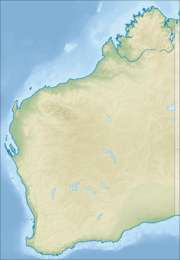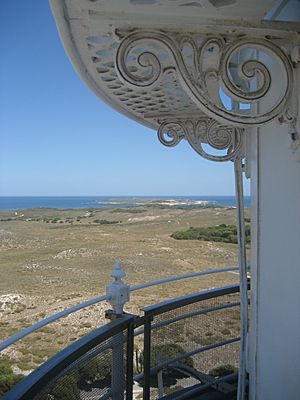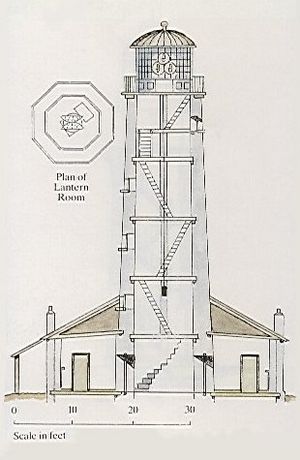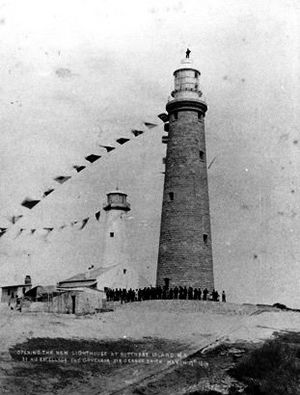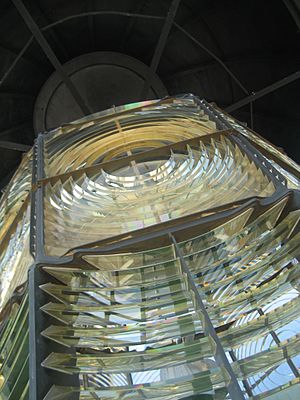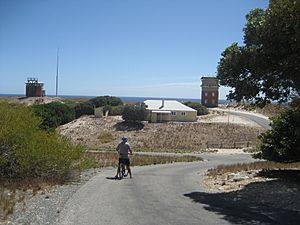Wadjemup Lighthouse facts for kids
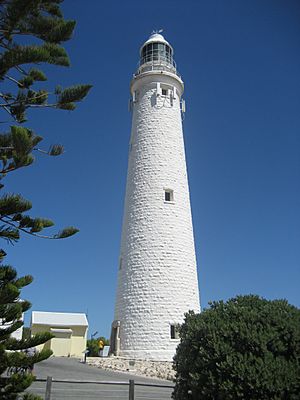 |
|
|
|
|
| Location | Rottnest Island Western Australia |
|---|---|
| Coordinates | 32°0′26″S 115°30′15″E / 32.00722°S 115.50417°E |
| Year first lit | 1896 |
| Automated | 1986 |
| Construction | limestone |
| Tower shape | tapered cylindrical tower with balcony and lantern |
| Markings / pattern | white tower and lantern |
| Height | 38.7 metres (127 ft) |
| Focal height | 80.5 metres (264 ft) |
| Intensity | 1,300,000 cd |
| Range | 26 nautical miles (48 km; 30 mi) |
| Characteristic | Fl W 7.5s. |
| Admiralty number | K1760 |
| NGA number | 9024 |
| ARLHS number | AUS-146 |
The Wadjemup Lighthouse, also known as the Rottnest Island Light Station, is an important lighthouse in Western Australia. The first lighthouse here was finished in 1849. It was the first stone lighthouse in Western Australia. Its main job was to help ships sail safely into Fremantle Port and the Swan River Colony.
A bigger lighthouse was built in 1896 in the same spot. This new lighthouse was Australia's first to have a rotating light beam. It is also the fourth oldest lighthouse still standing in Western Australia. After a shipwreck happened partly because of bad communication from the lighthouse, another lighthouse, the Bathurst Lighthouse, was built on the island in 1900.
Contents
Finding the Perfect Spot for the Lighthouse
Rottnest Island is the biggest island close to Fremantle Port. It is about 19 kilometers from the mouth of the Swan River. Ships arriving from the west usually see Rottnest Island first. The island is 11 kilometers long and 4.5 kilometers wide.
The lighthouse stands on Wadjemup Hill, the highest point of the island. The base of the tower is 45 meters above sea level. It is about 4 kilometers west of Thomson Bay and 2 kilometers southwest of Geordie Bay.
In 1840, explorers Commander John Clements Wickham and Lieutenant John Lort Stokes visited Rottnest Island. They were looking for a good spot for a lighthouse. Stokes wrote in his journal that they chose a hill towards the southeast end of the island.
Later that year, Surveyor-General John Septimus Roe, Wickham, and Stokes published sailing directions. They mentioned that a white obelisk (a tall, thin monument) had been built on the island's highest point. This obelisk was 15 feet tall and helped ships see the island from far away. They said this marker would soon be replaced by a taller lighthouse.
The First Lighthouse Tower
The first lighthouse was designed by Henry Trigg, who was in charge of public works. Construction started in January 1842. A builder named Bayley Maycock managed the work. The lighthouse was built using limestone from the island. Aboriginal people who were imprisoned on the island helped with the building work.
The first lighthouse keeper, Samuel Thomas, was appointed in 1849. His duties included using flags and flares to signal when ships arrived. Different signals showed if ships were north or south of the island. These signals were then sent to Fremantle.
The tower was finished in August 1849. The prison on the island closed for a short time, and the prisoners were moved back to the mainland. However, Aboriginal prisoners returned to the island between 1855 and 1931.
The lighthouse officially opened on June 1, 1851. This was the 22nd anniversary of the Colony. The light was a special revolving lamp designed in Fremantle. It used two sets of three oil lamps with silver mirrors. The light could be seen for 18 nautical miles. It flashed for five seconds, then went dark for 55 seconds. The whole light turned once every two minutes. It used coconut oil at first, then later colza oil and kerosene.
Samuel Thomas was replaced by Thomas Carter in 1853. Then, Samuel Duffield became the third lighthouse keeper in 1854. He lived on the island with his wife and four children. Duffield was the longest-serving lighthouse keeper at Rottnest. Lighthouse keepers lived a very isolated life back then.
In 1863, the British Admiralty described the light as revolving and flashing. It could be seen for 20 nautical miles on a clear day. They also explained how the lightkeeper would signal to a pilot when a ship arrived. If a ship needed a pilot at night, it would show lights, flares, or fire guns.
By the 1880s, the lighthouse was considered "behind the times." A new, more powerful light was ordered from England. In 1891, the government started planning for a completely new lighthouse.
The New Lighthouse Tower
Work on the new lighthouse began in March 1895. The foundation stone was laid by the Premier of Western Australia, Sir John Forrest. The new lighthouse was designed by British engineer William Douglass. C. Y. O'Connor, the colony's engineer-in-chief, oversaw the building. Douglass also designed the Cape Leeuwin Lighthouse.
The new 38.7-meter-tall tower was finished in 1896. It was built next to the original lighthouse. When it opened on March 17, The West Australian newspaper reported on its features. The light was very powerful and made by Chance Bros. in England. It had a clockwork system to make it turn.
The new tower was almost twice as tall as the old one. It had a much stronger lamp, which could be seen for 23 nautical miles. At the opening, Governor Sir Gerard Smith said the new light showed the "progress and vigour of the colony." Premier Forrest called it a "magnificent milestone."
The old tower was taken down shortly after the new one started working. The head keeper at that time was William Brown.
Over the years, the lighthouse's technology improved. In 1908, the old wick burners were replaced with new ones, making the light much brighter. In 1927, the light became even stronger. In 1929, a new mercury float system and an electric clockwork mechanism were installed. The light then flashed for 0.4 seconds with a 4.6-second dark period.
On January 15, 1936, the lighthouse was fully electrified. Its power increased to 1,300,000 candles. The light now flashed for 0.2 seconds with a 7.3-second dark period. The light apparatus turned once every minute.
The City of York Shipwreck
On July 12, 1899, the lighthouse was involved in a big shipwreck. A British ship called City of York crashed into a reef north of the island. The ship was carrying timber from San Francisco to Fremantle. The lighthouse keeper saw the ship about 30 kilometers away. It was stormy with heavy rain.
The keeper signaled to the ship by lighting a flare. This signal meant for the ship to wait for a pilot. However, the ship's captain misunderstood the signal. He thought it meant to keep coming towards what he believed was a pilot boat. Sadly, he sailed straight into the shallow reefs around the island. Eleven men, including the captain, drowned, and the ship was lost.
Another ship, Carlisle Castle, was also lost in the same storm on the south side of the island. All 24 to 26 people on board drowned. The lighthouse was not involved in this second shipwreck.
Partly because of the City of York incident and other shipwrecks, a second lighthouse was built on Rottnest Island in 1900 at Bathurst Point.
Other Buildings at the Lighthouse Site
The lighthouse area has several other important buildings:
- The Lighthouse tower (built in 1896).
- The foundations of the first 1849 tower, which are inside a small stone building nearby.
- The lighthouse keeper's cottage from the 1890s. This building is now used for accommodation.
- The Battery Observation Post (BOP). This was built during World War II. It was a lookout point used to help aim and fire guns from other batteries on the island. There are plans to restore it and open it for tourists.
- The Signals Building, which was used with the BOP.
- The Women's Army Barracks. This building housed officers and staff who worked at the BOP. Today, it is sometimes used by university and research groups working on the island.
Visiting the Lighthouse Today
The Wadjemup Lighthouse became automatic in November 1986. This means it no longer needs a person to operate it all the time. The last lighthouse keeper left the island in 1990. The lighthouse is now managed by the Australian Maritime Safety Authority.
It is a popular place for tourists to visit. Volunteer guides offer tours of the lighthouse area and to the top of the tower. There are 155 steps to climb to the top! From there, you can see amazing views of the island's coastline and even back to the mainland near Perth.
The light itself is a large, powerful lens system made by Chance Brothers. It rotates once every 60 seconds on a mercury float. It uses electricity from the island's power supply and has a diesel backup system in case of power cuts.
The light is 80.5 meters above sea level. It can be seen from far away. Currently, it flashes once for a very short time (0.07 seconds) every 7.5 seconds.
Award for Engineering History
The Wadjemup Lighthouse and its signal station have received a Historic Engineering Marker from Engineers Australia. This award is part of their program to recognize important engineering achievements.
Images for kids


